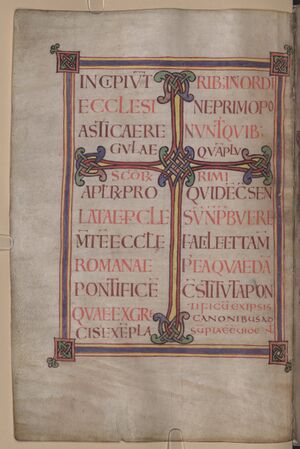München, BSB, Clm 6242
| Library | München, BSB |
|---|---|
| Shelfmark | Clm 6242 |
| Century | s. IX¼/IX⅓ |
| Provenance | ? |
| Place of origin | Freising, Cathedral Chapter |
| European region of origin | Southern Germany |
| General region of origin | Germany |
| Specific region of origin | Bavaria |
| Collection | Collectio XXX capitulorum |
| Collection 2 | Collectio Dionysio-Hadriana |
| Digital Images | digitale-sammlungen.de |
| Author | Bruno Schalekamp |
München, Bayerische Staatsbibliothek, Clm 6242 is an early ninth-century manuscript of 311 folios in 1 col. (fols. 1r-3r and 22v-311v) and 2 cols. (fols. 3va-22rb and some episcopal/clerical lists not mentioned here) (315 x 210 mm). Its codicological composition reads as follows: 40 quires: IV8 + (V – 1)17 + (III – 1?)22 + (IV + 1?)31 + 18 x IV175 + III181 + 13 x IV285 + (IV – 2)292; restored quires: 2 x IV307 + (III – 2?)311, quire signatures in Roman numerals start at I31 until XX181, no signatures hereafter. Modern folio numbering in Arabic numerals are found on the recto side of each folio in a modern hand. It was written by numerous (but unknown amount of) hands in Caroline minuscule according to Bischoff and contains some additions from s. X according to its catalogue. The vast part was written in saec. IX⅓, after 811, according to Kéry and Mordek, saec. IX, ca. 815-825 according to Bierbrauer, or saec. IX¼ according to Bischoff and Bergmann. The manuscript's origins can be traced to Freising and was probably penned down under the rule of bishop Hitto (811-835). The manuscript's provenance is from the Cathedral Chapter of Freising based on a signature on fol. 1r, which reads: Liber iste est sancte marie sanctique corbiniani frising[e] (by hand from s. XII).
Contents
München Clm 6242 is a large and bulky codex and contains exclusively canonical material, with some very small relevant encyclopedic additions of Isidore de Seville. The canonical part is dominated by the Collectio Dionysio-Hadriana, which takes up close to 300 folios of the manuscript. Other works included are some epistles (Nicholas I and Gregory III), papal decretals (among others, Gregory the Great, Gelasius, and Pseudoisidore), various conciliar canons (Ancyra, Neo-Caesarea, and Rome), and a canonical collection (Collectio XXX capitulorum, which is one of the more complete witnesses).

The manuscript is an immense and expensive work, which had a lot of resources poured into it and must have a significant amount of scribal effort. The work contains some eye-catching large illuminated capitals and is well-structured, indicating the base text was deliberately planned out and ruled beforehand. Furthermore, the Collectio Dionysio-Hadriana includes helpful signs of chapters on the top of every folio side, making the manuscript easy to manage. Some marginalia can be found next to the base text of the aforementioned collection, which seem to have been added at a not much later stage. In between the lines, some corrections or clarifications were also added. Lastly, the manuscript is very well-preserved, except for the first eight and last two folios: the former seem to have been the victim of some water damage, while the latter have been prone to other forms of wear-and-tear.
See the digitized version: https://www.digitale-sammlungen.de/view/bsb00036889?page=1.
| folios | content |
|---|---|
| Front cover and flyleaf | |
| 1r-2r | Epistle of pope Nicholas I (no. 138) to Solomon I, bishop of Constance |
| 2r | Two versions of the first canon of the Council of Ancyra (314) |
| 2v-289v | Collectio Dionysio-Hadriana |
| 22v-23r | Blank pages |
| 289v-291v | Decretal of pope Gregory the Great concerning the Council of Rome (595) |
| 292r-299r | St. Augustine's De haeresibus |
| 299r-303r | Isidore de Seville's Etymologiae, book 8, chapter 5 |
| 303r-308v | Collectio XXX capitulorum, chapters I-XXX |
| 308v-310r | Excerpts of Pseudoisidore's False Decretals |
| 310r | Excerpt of canon 14 of the Council of Mainz (847) |
| 310v | Small collection of titulary excerpts of various councils, such as those at Ancyra, Neo-Caesarea and Carthage, and papal decretals, such as those of Gelasius, Innocent and Anastasius |
| 311r | Excerpt of the Council of Rome (743) organized by pope Zachary, canon 15 |
| 311v | Excerpt of an epistle of pope Gregory III to St. Boniface |
| 311v | Pope Gregory II's In constitutis Gregorii papae |
| 311v | Excerpt of Isidore de Seville's Etymologiae, book 9, chapter 6 |
| 311v | Some probationes pennae from the middle to the end of the verso side |
| Flyleaf and back cover |
Literature
Bergmann, Stricker, Goldammer, Wich-Reif, Katalog Vol. 3 (2005), p. 1024-1025 n. 509; Bierbrauer, Die vorkarolingischen und karolingischen Handschriften (1990), p. 27; Bischoff, Katalog der festländischen Handschriften (2004), p. 233 n. 3000; Bischoff, Schreibschulen Vol. 1 (1974), p. 100-101 and 215; Glauche, Katalog der lateinischen Handschriften (2000), p. 66-70; Kéry, Canonical Collections (1999), p. 15, 76, and 81; Mordek, Kirchenrecht und Reform p. 259; Reynolds, Law and Liturgy (1994), p. 115 (IV); Sdralek, ‘Handschriftlich-kritische Untersuchungen’ (1882), p. 192.
An edition of the Collectio XXX capitulorum is currently being prepared by Sven Meeder, Gideon de Jong, and Bruno Schalekamp.
